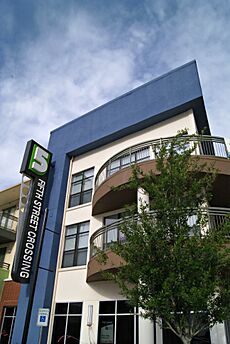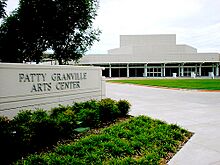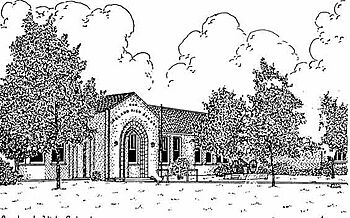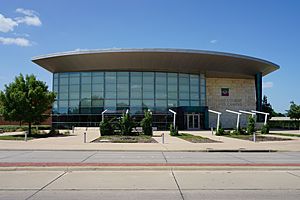Garland, Texas facts for kids
Quick facts for kids
Garland
|
||
|---|---|---|
|
Pleasant Valley Bridge in Garland, 2024
|
||
|
||
| Motto(s):
Texas Made Here
|
||

Location within Dallas County
|
||
| Country | United States | |
| State | Texas | |
| County | Dallas, Collin, Rockwall | |
| Incorporated | 1891 | |
| Government | ||
| • Type | Council-Manager | |
| Area | ||
| • Total | 57.25 sq mi (148.29 km2) | |
| • Land | 57.13 sq mi (147.97 km2) | |
| • Water | 0.12 sq mi (0.31 km2) | |
| Elevation | 551 ft (168 m) | |
| Population
(2020)
|
||
| • Total | 246,018 | |
| • Rank | US: 93rd TX: 13th |
|
| • Density | 4,297.3/sq mi (1,659.03/km2) | |
| Time zone | UTC−6 (CST) | |
| • Summer (DST) | UTC−5 (CDT) | |
| ZIP codes |
75040-75049
|
|
| Area code(s) | 214, 469, 945, 972 | |
| FIPS code | 48-29000 | |
| GNIS feature ID | 2410572 | |
Garland is a large city in the state of Texas, United States. It is mostly located in Dallas County, but parts of it also reach into Collin and Rockwall counties. Garland is northeast of Dallas and is part of the big Dallas–Fort Worth metroplex area.
In 2020, Garland had a population of over 246,000 people. This makes it the 93rd most populated city in the United States and the 13th most populated city in Texas. Garland is the third largest city in Dallas County by population. You can easily travel to downtown Dallas from Garland using public transportation like the DART Blue Line trains and buses.
Contents
- History of Garland: From Small Towns to a Big City
- Geography and Climate of Garland
- People and Diversity in Garland
- Economy: What Garland Makes and Does
- Arts and Culture: Fun Things to Do in Garland
- Parks and Recreation: Get Outdoors in Garland
- Education: Schools and Colleges in Garland
- Infrastructure: Getting Around and Utilities
- Notable People from Garland
- Images for kids
- See also
History of Garland: From Small Towns to a Big City
Garland's story began around 1850 when people started moving to the area. However, a real community didn't form until 1874. At first, there were two small towns: Embree and Duck Creek. They were rivals, especially as the area grew near the Santa Fe Railroad station.
How Garland Got Its Name
To solve a disagreement about where the local post office should be, a judge asked Congressman Joe Abbott to move it between the two towns. This happened in 1887. The new spot was named Garland after the U.S. Attorney General at the time, Augustus Hill Garland.
Soon after, Embree and Duck Creek joined together. These combined areas then formed the city of Garland, which officially became a city in 1891. By 1904, Garland had a population of 819 people.
Early Growth and Important Businesses
In 1920, local business owners helped fund a new power plant for the town. This led to the creation of Garland Power and Light, which still provides electricity to the city today.
On May 9, 1927, a very strong tornado hit Garland. It caused a lot of damage and sadly, 15 people lost their lives, including the former mayor, S. E. Nicholson.
Businesses started to return to Garland in the late 1930s. The Craddock food company and the Byer-Rolnick hat factory (now known as Resistol) moved in. In 1937, KRLD, a big radio station from Dallas, built its antenna tower in Garland. It is still used today.
Garland's Population Boom and Modern Developments
During World War II, several aircraft factories operated in Garland. After the war, Kraft Foods bought one of these factories for its own use. By 1950, Garland's population grew to over 10,000 people.
From 1950 to 1954, the Dallas/Garland area faced a long drought. To get more water, Garland started using water from nearby Lake Lavon.
After World War II, many suburbs across the country grew quickly, and Garland was no exception. By 1960, the population had almost quadrupled to about 38,500. By 1970, it doubled again to about 81,500, and by 1980, it reached 138,850.
In the 2000s, Garland added many new places, especially in the northern part of the city.
- Hawaiian Falls waterpark opened in 2003.
- The Garland Independent School District's Curtis Culwell Center, a large arena and conference building, opened in 2005.
- Later that year, Firewheel Town Center, an outdoor shopping mall, opened in October 2005. It has over 100 businesses and an AMC movie theater.
In 2009, the city worked with a developer to create 5th Street Crossing. This new area has apartments, shops, and is close to the downtown DART train station.
On December 26, 2015, a large tornado, known as an EF4 tornado, hit the southeast side of Garland. This event sadly caused nine deaths in the city.
Geography and Climate of Garland
Garland covers about 57.1 square miles (147.9 square kilometers) of land.
Garland's Neighborhoods and Communities
Garland has many different neighborhoods and historic communities, including:
- Buckingham North
- Duck Creek
- Centerville
- Club Hill
- Eastern Hills
- Embree
- Firewheel
- Oaks
- Rose Hill
- Spring Park
- Travis College Hill Addition
- Valley Creek
- The 5
- Oakridge
- Brentwood Place
- Brentwood Village
Garland's Weather and Climate
Garland has a humid subtropical climate. This means it has hot, humid summers and mild winters. The warmest month is usually July. The highest temperature ever recorded was 111°F (44°C) in 2000. January is typically the coolest month, with the lowest temperature ever recorded being -3°F (-19°C) in 1989. The most rain usually falls in May.
People and Diversity in Garland
| Historical population | |||
|---|---|---|---|
| Census | Pop. | %± | |
| 1890 | 478 | — | |
| 1900 | 819 | 71.3% | |
| 1910 | 804 | −1.8% | |
| 1920 | 1,421 | 76.7% | |
| 1930 | 1,584 | 11.5% | |
| 1940 | 2,233 | 41.0% | |
| 1950 | 10,571 | 373.4% | |
| 1960 | 38,501 | 264.2% | |
| 1970 | 81,437 | 111.5% | |
| 1980 | 138,857 | 70.5% | |
| 1990 | 180,650 | 30.1% | |
| 2000 | 215,768 | 19.4% | |
| 2010 | 226,876 | 5.1% | |
| 2020 | 246,018 | 8.4% | |
| 2023 (est.) | 243,470 | 7.3% | |
| U.S. Decennial Census Texas Almanac: 1850–2000 2020 population |
|||
Garland is a very diverse city. According to the 2020 United States census, there were 246,018 people living in the city. The population density was about 3,973 people per square mile (1,534 per square kilometer).
In 2010, about 36.9% of households had children under 18 living with them. The average household had about 3 people, and the average family had almost 3.5 people.
Diversity in Garland's Population
Garland's population is made up of people from many different backgrounds. In 2020, the city's population included:
- 27.31% non-Hispanic White
- 14.77% Black or African American
- 0.25% Native American
- 11.88% Asian
- 0.03% Pacific Islander
- 0.38% other races
- 2.72% people of two or more races
- 42.66% Hispanic or Latino (who can be of any race)
Garland has a notable Vietnamese American community. In 2000, 12% of the foreign-born population in Garland was from Vietnam. There are shopping areas and a community center that serve the Vietnamese community. In fact, Garland has one of the largest Vietnamese American populations in the United States.
Religious Life in Garland
Many people in Garland are part of a religion. The Catholic Church is the largest Christian group in Garland and the wider Dallas-Fort Worth area. After Catholics, Baptists are the second-largest Christian group. Other Christian groups include Methodists, Latter-Day Saints, Pentecostalism, Lutheranism, Presbyterianism, and Episcopalians.
Besides Christianity, the largest non-Christian religion in Garland is Islam, followed by Judaism and eastern religions like Buddhism, Sikhism, and Hinduism.
Economy: What Garland Makes and Does
Garland has a strong history of manufacturing and business. In the late 1930s, the Craddock food company, which made pickles, moved to town. The KRLD radio tower was built here in 1937.
During World War II, several aircraft factories operated in Garland. After the war, Kraft Foods bought one of these plants, and it still operates today. In the 1940s, Garland was also a big shipping point for onions because of its railroad connections.
Famous Hats from Garland
Resistol Hats is a famous company in Garland that makes high-quality hats. Many famous people have worn or received these hats. The company started in Dallas in 1927 and moved to Garland in 1938. The name "Resistol" came from the idea that the hats could "resist-all" weather conditions. For many years, people in Garland could tell the time by the whistle from the hat factory.
In the early 1980s, Garland had one of the lowest poverty rates in the country. By 1990, it was Dallas County's second-largest city with a population of 180,650 and 2,227 businesses. Today, Garland has many different industries, including electronics, steel, oilfield equipment, aluminum die casting, hat making, dairy products, and food processing. Wingstop was also founded here.
Top Employers in Garland
Here are some of the largest employers in Garland:
| # | Employer | Employees |
|---|---|---|
| 1 | Garland Independent School District | 7,425 |
| 2 | City of Garland | 2,000 |
| 3 | Kraft Foods | 796 |
| 4 | US Food Service | 520 |
| 5 | Epiroc Drilling Solutions | 460 |
| 6 | SilverLine Window | 425 |
| 7 | Hatco (Resistol) | 390 |
| 8 | L3-Communication | 350 |
| 9 | Arrow Fabricated Tubing | 340 |
| 10 | Valspar | 300 |
Many major employers in Garland have changed over the years. For example, a former Raytheon campus was rebuilt into new industrial buildings for companies like Lexor, Ecolab, Apple, and Quest Windows. The large Sears distribution building is now used by Costco wholesale. The Baylor Scott and White hospital has become a new VA Medical Center. The City of Garland is also planning to improve the area around the medical district to attract a new community hospital.
Arts and Culture: Fun Things to Do in Garland
Garland has many places for entertainment and learning about history.
Entertainment Venues
The Granville Arts Center is a big complex owned by the city. It has two beautiful theaters that can seat 720 and 200 people. The Plaza Theatre, a historic entertainment spot, is also part of the complex and seats 350. The Plaza Theatre has been updated and is used for concerts, events, and plays. It also features paintings by artist Bruce Cody. The Atrium at the Granville Arts Center is a large ballroom with glass walls, perfect for banquets, trade shows, and conventions.
Historic Landmarks to Explore
Garland is home to the Pace House, an old home built in the Queen Anne style. It was recognized as a historic landmark in 1982.
Another historic place is the Garland Landmark Museum, located in the old 1901 Santa Fe train station. Inside, you can find historical items and documents from 1850 to today. Historic Downtown Garland is also a local landmark and was added to the National Register of Historic Places in 2017.
The Travis College Hill Historic District is a neighborhood in downtown Garland. It was the first place in Garland to be added to the National Register of Historic Places. This district has 12 homes that were built between 1913 and 1960.
After the devastating tornado in 1927, the Nicholson Memorial Library opened in honor of former mayor S. E. Nicholson. This library system is also the main headquarters for the Northeast Texas Library System (NETLS), which serves 105 libraries in a 33-county area.
Parks and Recreation: Get Outdoors in Garland
Garland has over 2,880 acres (11.6 square kilometers) of park land. It also has six recreation centers and 63 parks, offering many opportunities for outdoor activities and sports.
Education: Schools and Colleges in Garland
Primary and Secondary Schools
Most of Garland is part of the Garland Independent School District (GISD). Some parts of the city are also in the Dallas, Mesquite, and Richardson Independent School Districts.
The GISD does not have school zones, which means students living in the GISD can apply to any school within the district.
GISD has several high schools:
- Garland High School is known for its international baccalaureate program.
- North Garland High School specializes in math, science, and technology.
- Lakeview Centennial High School is the "College and Career" magnet school.
- South Garland High School is known for its cosmetology program.
- Other GISD high schools include Naaman Forest, Rowlett, and Sachse High Schools.
For private education, many families choose Garland Christian Academy, a Christian school founded in 1972. Garland also has an Islamic school called Brighter Horizons Academy for students from Pre-K to 12th grade.
Colleges and Universities
Residents of Dallas County can attend Dallas College (formerly Dallas County Community College). Richland College, which is part of Dallas College, has a campus in Garland that opened in 2009.
Garland is also home to Amberton University, a private university that offers both undergraduate and graduate degrees.
Infrastructure: Getting Around and Utilities
Garland has good transportation options and reliable public services.
Transportation in Garland
Most households in Garland have cars. In 2016, only about 4.4% of households did not have a car, which is much lower than the national average. On average, Garland households had about 2 cars. Most residents drive alone to work (78.8%), while 13.1% carpool. About 2.5% use public transportation.
Major Highways
 Interstate 30 is a main east-west highway that runs through the south side of Garland. It connects Garland to Mesquite and Dallas to the west, and Rockwall to the east.
Interstate 30 is a main east-west highway that runs through the south side of Garland. It connects Garland to Mesquite and Dallas to the west, and Rockwall to the east. Interstate 635 (Lyndon B. Johnson Freeway) is a highway that forms a partial loop around Dallas and its suburbs. It runs along the southwest part of Garland and acts as a border between Dallas and Garland. This highway connects Garland to other major freeways and Dallas/Fort Worth International Airport.
Interstate 635 (Lyndon B. Johnson Freeway) is a highway that forms a partial loop around Dallas and its suburbs. It runs along the southwest part of Garland and acts as a border between Dallas and Garland. This highway connects Garland to other major freeways and Dallas/Fort Worth International Airport. Texas State Highway 66 is an east-west highway that ends in downtown Garland. East of downtown, it connects to Rowlett and Rockwall.
Texas State Highway 66 is an east-west highway that ends in downtown Garland. East of downtown, it connects to Rowlett and Rockwall. Texas State Highway 78 (Garland Road, Lavon Drive) is a north-south highway that goes through the middle of Garland and its downtown area. It connects to Sachse and Wylie to the north, and East Dallas to the south.
Texas State Highway 78 (Garland Road, Lavon Drive) is a north-south highway that goes through the middle of Garland and its downtown area. It connects to Sachse and Wylie to the north, and East Dallas to the south. President George Bush Turnpike is a toll road that loops around Dallas County. It runs through the northern parts of Garland and connects to Richardson and Plano to the west, and Rowlett to the east.
President George Bush Turnpike is a toll road that loops around Dallas County. It runs through the northern parts of Garland and connects to Richardson and Plano to the west, and Rowlett to the east.- Belt Line Loop is another road that forms an outer loop around the Dallas suburbs.
Trains in Garland
A Kansas City Southern train track runs next to State Highway 78, going from Dallas through Garland towards Wylie. There is also a Dallas, Garland and Northeastern Railroad line that serves businesses in the city.
Light Rail Trains
Garland has light rail service provided by DART on its Blue Line. There are two stations:
- Forest/Jupiter station
- Downtown Garland station
Air Travel
The city of Garland owns the Garland/DFW Heloplex, which is a facility for helicopters. It was the first city-owned heliport in Texas when it opened in 1989.
Utilities: Water and Power
The city of Garland manages its own water system and waste services. About 85% of Garland's electricity comes from the city's own utility, Garland Power and Light (GP&L). The other 15% is supplied by different companies.
Water and Wastewater Services
Garland is a founding member of the North Texas Municipal Water District (NTMWD). This means Garland gets reliable, high-quality, and affordable water from the district's reservoirs.
The water from Garland's wastewater treatment plant flows through a large, man-made wetland. This wetland, which is about 1,840 acres (7.4 square kilometers), helps clean the water naturally. It also provides a home for many birds and reduces pollutants in the water, making it cleaner and more environmentally friendly.
Garland Power and Light (GP&L)
GP&L was started in 1923 to provide electricity to Garland residents. It is a not-for-profit public utility that is controlled by the city's citizens. GP&L serves over 69,000 customers, making it the fourth-largest city-owned utility in Texas and the 41st-largest in the nation.
GP&L has two power plants that use natural gas, which can produce 640 megawatts of electricity. Garland also works with the Texas Municipal Power Agency, which operates a large coal-fired power plant. Garland's electricity system has over 1,007 miles (1,621 kilometers) of overhead lines and 1,000 miles (1,609 kilometers) of underground lines. It also has 23 substations and 133 miles (214 kilometers) of transmission lines.
Notable People from Garland
Many interesting people have connections to Garland:
- Hakeem Adeniji, an offensive lineman for the Cincinnati Bengals (NFL).
- Troy Baker, a voice and screen actor known for video games, attended Naaman Forest High School.
- Tyson Ballou, a model.
- Crystal Bernard, an actress from TV shows like Happy Days and Wings.
- Mookie Blaylock, an NBA basketball player.
- Johnny Yong Bosch, an actor, musician, and martial artist, grew up in Garland.
- C. L. Bryant, a Baptist minister and talk-show host, lived in Garland.
- Amber Dotson, a country music artist.
- Brian Adam Douglas, an artist.
- Samuel Eguavoen, a football player.
- Anu Emmanuel, an actress.
- William Jackson Harper, an actor and playwright, grew up in Garland.
- Caleb Landry Jones, an actor.
- Chris Jones, a basketball player for Valencia Basket and the Armenian national team.
- Tyrese Maxey, a basketball player for the Philadelphia 76ers.
- Adrienne Palmer, a professional wrestler known as Athena.
- Mitchel Musso, an actor and musician.
- Adrian Phillips, an NFL football player.
- Ricky Pierce, an NBA guard and All-Star, grew up in Garland.
- LeAnn Rimes, a musician, grew up in Garland.
- Gene Summers, a musician.
- Lee Trevino, a famous golfer, was born in Garland in 1939.
- LTC Allen West, a politician and former Florida Congressman.
Images for kids
See also
 In Spanish: Garland (Texas) para niños
In Spanish: Garland (Texas) para niños










